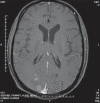Toxoplasmosis of spinal cord in acquired immunodeficiency syndrome patient presenting as paraparesis: a rare entity
- PMID: 25538456
- PMCID: PMC4265833
- DOI: 10.4103/0974-777X.145248
Toxoplasmosis of spinal cord in acquired immunodeficiency syndrome patient presenting as paraparesis: a rare entity
Abstract
Although brain has been the most common site for toxoplasma infection in acquired immunodeficiency syndrome patients, involvement of spinal cord by toxoplasma has been rarely found. Spinal cord toxoplasmosis can present as acute onset weakness in both lower limbs associated with sensory and bladder dysfunction. A presumptive diagnosis can be made in patients with CD4 count <100/mm(3) based on a positive serum Toxoplasma gondii IgG antibodies, no recent prophylaxis against toxoplasmosis, intramedullary ring enhancing lesion in spinal cord supported by similar lesions in brain parenchyma. Institutions of antitoxoplasma treatment in such patients result in prompt clinical response and therefore avoiding the need of unnecessary invasive diagnostic tests. Here, we report a case of toxoplasmic myelitis in immunocompromised patient presenting as myelopathy who showed significant clinical improvement after starting antitoxoplasma treatment. Hence toxoplasmic myelitis should be considered in toxoplasma seropositive immunocompromised patients presenting as myelopathy and imaging studies showing ring enhancing intramedullary lesion.
Keywords: Acquired immunodeficiency syndrome; Immunocompromised; Paraparesis; Spinal toxoplasmosis.
Conflict of interest statement
Figures
References
-
- Di Rocco A. Diseases of the spinal cord in human immunodeficiency virus infection. Semin Neurol. 1999;19:151–5. - PubMed
-
- Teja VD, Talasila SR, Vemu L. Neurologic manifestations of HIV infection: An Indian hospital-based study. AIDS Read. 2005;15:139–43. C3. - PubMed
-
- Resnick DK, Comey CH, Welch WC, Martinez AJ, Hoover WW, Jacobs GB. Isolated toxoplasmosis of the thoracic spinal cord in a patient with acquired immunodeficiency syndrome. Case report. J Neurosurg. 1995;82:493–6. - PubMed
-
- Vyas R, Ebright JR. Toxoplasmosis of the spinal cord in a patient with AIDS: Case report and review. Clin Infect Dis. 1996;23:1061–5. - PubMed
Publication types
LinkOut - more resources
Full Text Sources
Other Literature Sources
Research Materials



